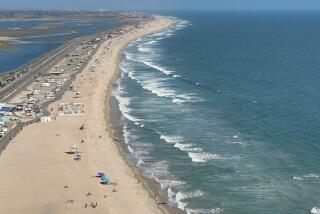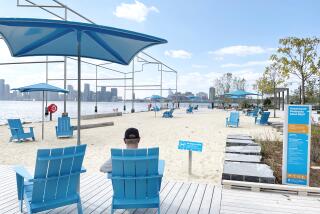Lake Michigan Serenaded by ‘Singing Sand’
- Share via
HOFFMASTER STATE PARK, Mich. — The theater is darkened, engulfed in the sound of crashing waves, as the story of sand dune creation unfolds on screen. First comes formation of the beach--fore dune, trough, back dune and barrier dune. A fragile environment springs to life next, grasses at first, followed by woody plants and eventually a forest of hemlock and sugar maple on the back and barrier dunes.
The theater is part of this 1,054-acre park established in 1967 to protect and preserve Lake Michigan’s 2 1/2-mile stretch of towering sand dunes. The park’s centerpiece is the 13-year-old Genevieve Gillette Nature Center, a $500,000 complex including the Sand Dune Theater dedicated to the interpretation of sand piles.
“Dunes are home to many unique plants and animals,” said Earl Wolf, 37, a park naturalist here for the last 10 years.
The giant sand piles along the eastern shore of Lake Michigan collectively represent the world’s largest accumulation of sand dunes bordering fresh water. Michigan, with its unique Sand Dune Protection and Management Statute, has 275,000 acres of sand dunes, 40% in public ownership.
Snow often covers the dunes this time of year and visitors can be seen navigating the park’s 10-mile trail on snow shoes or skis. They are accompanied by a symphony of chirping birds--including black cap chickadees, white-breasted nut hatches, tufted titmice, blue jays, red-bellied woodpeckers and meadowlarks--and squirrels who scamper across the snow amid a maze tracks left by red fox and white-tail deer.
Soon, tiny spring peeper frogs will be peeping robustly as colorful painted turtles scurry about with spotted salamanders and other wildlife. And as the snow melts, visitors to the ice-clogged shoreline will experience “singing sand,” a sound heard few places on Earth.
“It’s a very special tune played by the sand,” said park ranger Elizabeth Brockwell, 23. “You scoot your feet along the beach and when the right amount of moisture is present, tiny sand particles scrape against each other and emit a peculiar musical whistle or squeaking sound.”
The center is filled with graphics describing dune formation and growth here and throughout the world. Exhibits portray plants and animals found in sand dune ecosystems and a gallery is devoted to works by Jeanne Rockette and other Michigan sand dune artists.
Visitors, including thousands of schoolchildren, ascend the wooden Dune Climb Stairway that winds to the top of 220-foot-high Sugar Hill and overlooks 190-foot Mt. Baldy and a breathtaking sweep one of Michigan’s most scenic beaches.
The park is named after the late P. J. (Pete) Hoffmaster, Michigan’s first superintendent of parks; the sand dune museum in honor of Genevieve Gillette, who died two years ago at 88.
Known as Michigan’s “Miss State Park,” Gillette was the first woman to receive a degree in landscape architecture at an American university (Michigan State). From the 1920s until her death, she was a leader in establishing Michigan’s park system. Gillette wrote Michigan’s wilderness bill, was the first president of Michigan’s Parks Assn. and was named to the 12-member Citizen’s Advisory Committee on Recreation and Natural Beauty by President Lyndon B. Johnson in 1966.
More to Read
Sign up for The Wild
We’ll help you find the best places to hike, bike and run, as well as the perfect silent spots for meditation and yoga.
You may occasionally receive promotional content from the Los Angeles Times.






